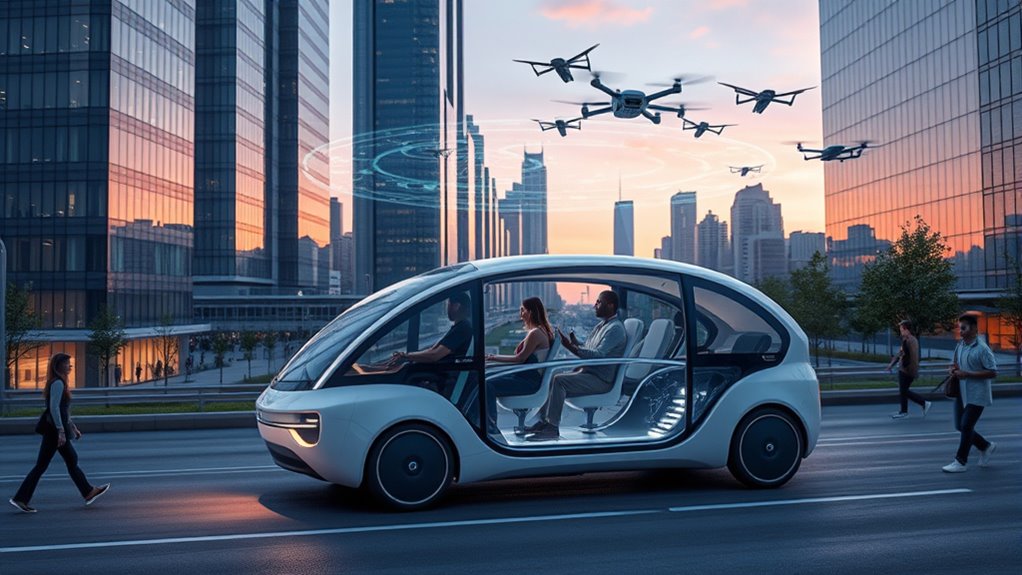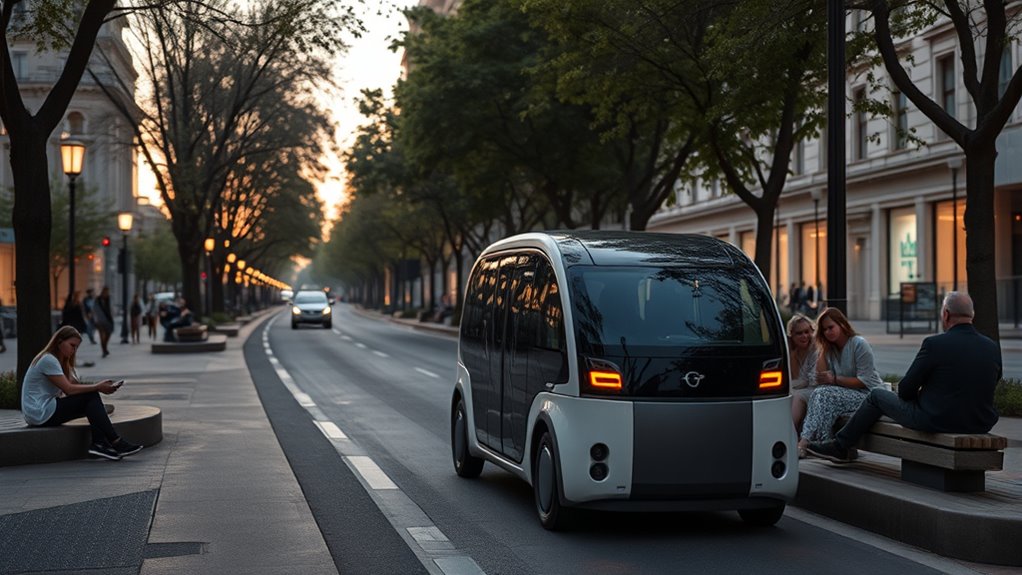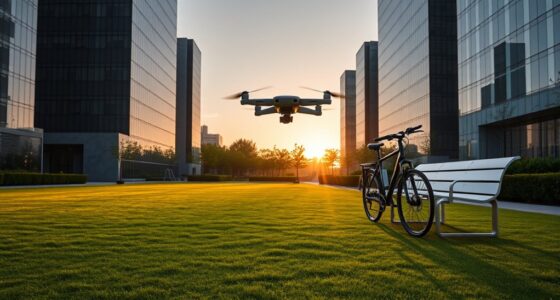Shared autonomy means sharing decision-making and control within teams, moving beyond traditional ownership and hierarchy. Instead of individuals holding all responsibility, everyone contributes their expertise, fostering trust, innovation, and shared accountability. This approach promotes open communication, flexibility, and a sense of ownership among team members. By embracing shared autonomy, you create a more collaborative, resilient work environment—if you explore further, you’ll discover how to implement these ideas effectively in your organization.
Key Takeaways
- Shared autonomy distributes decision-making among team members, fostering collaboration and reducing reliance on hierarchical ownership.
- It enhances trust, engagement, and innovation by valuing diverse perspectives and shared responsibilities.
- Technology tools enable seamless communication and real-time collaboration, supporting a distributed and flexible workforce.
- Overcoming resistance and managing power dynamics are essential for effective implementation of shared autonomy.
- Moving beyond ownership cultivates a resilient, motivated team adaptable to evolving work environments.

Shared autonomy is transforming the way teams operate by distributing decision-making and control among members rather than centralizing them in a few individuals. When you embrace this approach, you move away from traditional hierarchies, empowering everyone to contribute their expertise and insights. Instead of relying on a single leader or manager to make all decisions, shared autonomy encourages joint decision-making, where all perspectives are valued before arriving at a conclusion. This collaborative process helps your team work more effectively, as responsibilities are shared based on each member’s strengths and interests, leading to more efficient work distribution. As a result, team members feel a greater sense of ownership and engagement, which boosts motivation and job satisfaction. Shared decision-making fosters a culture of trust and mutual respect, which is essential for sustaining long-term collaboration. By involving everyone in decision-making, shared autonomy promotes a culture of innovation. When diverse viewpoints come together, creative solutions are more likely to emerge. You benefit from a wider pool of ideas, which enhances your team’s ability to solve complex problems. Communication becomes more open and dynamic, fostering mutual respect and stronger collaboration. As team members work side by side, they learn from each other, building trust and improving overall teamwork. This environment not only makes work more enjoyable but also increases productivity, since everyone feels responsible for the team’s success. Incorporating effective communication techniques can further strengthen this collaborative environment, ensuring that all voices are heard and understood.
Shared autonomy empowers teams through collaborative decision-making and shared responsibilities, boosting engagement and effectiveness.
Of course, adopting shared autonomy isn’t without challenges. Resistance can arise from those accustomed to traditional structures, and effective communication is essential to prevent misunderstandings. Building trust among team members is necessary, as everyone needs to feel confident in each other’s accountability. Power dynamics can also complicate things; you must guarantee that participation is equal and that no one dominates decision-making. Establishing clear performance metrics becomes necessary to measure success in this new model, helping you and your team stay aligned with organizational goals. When managed well, these hurdles can be overcome, resulting in a more motivated, innovative, and cohesive team.
Technology plays a pivotal role in enabling shared autonomy. Collaboration tools, decision-making software, and data-sharing platforms facilitate seamless communication and real-time updates. These tools support remote and hybrid work arrangements, expanding the possibilities for shared autonomy beyond traditional office settings. Feedback mechanisms allow you to continuously refine processes, ensuring that your team adapts and improves over time. With the right technological support, you can create an environment where everyone is empowered to participate fully, regardless of location or role.
Shared autonomy is especially prevalent in startups, where flexibility and innovation are essential. However, larger organizations can also benefit by fostering a culture of shared control. By moving beyond ownership of decisions, you help build a more dynamic, resilient, and motivated workforce ready to thrive in an increasingly less hierarchical world.
Frequently Asked Questions
How Does Shared Autonomy Impact Traditional Job Security?
Shared autonomy changes how you experience job security by giving you more control over your work and flexibility. This can boost your confidence and sense of stability, but it also introduces new risks, like job insecurity if you lack skills to adapt. You might find more opportunities for growth, yet need to stay proactive in skill development. Overall, shared autonomy shifts job security from traditional guarantees to personal adaptability and ongoing learning.
What Legal Rights Do Users Have Over Shared Autonomous Assets?
You have several legal rights over shared autonomous assets. You can use them non-exclusively, enjoy benefits like income or services, and sometimes transfer your interest. Your rights also include access to maintenance, data protection, and protection from unfair practices through consumer laws. These rights depend on ownership agreements and applicable laws, and dispute resolution mechanisms help safeguard your interests if disagreements arise. Always review your agreements to understand your specific rights.
How Does Shared Autonomy Influence Urban Infrastructure Development?
Shared autonomy shapes urban infrastructure by freeing up space previously dedicated to parking and fuel stations, allowing you to repurpose land for green spaces, housing, and commercial areas. It encourages smarter street designs with dedicated drop-off zones and improved traffic flow through intelligent signals. This shift reduces congestion and emissions, making your city more sustainable and vibrant. You benefit from better accessibility, lower transportation costs, and a healthier environment as infrastructure adapts to these new mobility patterns.
What Are the Privacy Concerns With Shared Autonomous Systems?
Did you know that autonomous systems collect up to 4 terabytes of data daily? Your privacy concerns include unauthorized access, data breaches, and misuse of personal info like location and habits. When data is shared with third parties without your clear consent, risks of profiling, surveillance, and identity theft increase. You need better security measures, transparency, and strict regulations to protect your data and privacy in autonomous systems.
How Do Insurance Models Adapt to Shared Autonomous Usage?
You need to understand that insurance models adapt by shifting liability from drivers to manufacturers and fleet operators, reflecting the shared autonomous usage. Policies become more specialized, covering software, hardware, and data security. You’ll see hybrid options for different autonomy levels, and insurers will rely on real-time vehicle data for claims. Regulations and consumer acceptance also shape these models, ensuring coverage remains relevant as autonomous technology and shared usage grow.
Conclusion
As you embrace shared autonomy, remember that “it takes a village.” Moving beyond ownership means collaborating more efficiently and valuing collective effort over individual possession. In a working-less world, your role shifts from control to partnership, revealing new possibilities for innovation and sustainability. By trusting shared systems and relationships, you create a future where resources are optimized and life becomes more balanced. Embrace the change, because together, we can build a smarter, more connected world.









